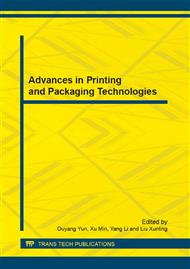p.460
p.464
p.470
p.475
p.480
p.486
p.491
p.497
p.501
Study on Thickening after Preparation Phenomenon of Alcohol-Based Gravure Ink
Abstract:
The thickening after preparation phenomenon of ink refers to the viscosity of ink after preparation is constantly changing during its storage process. The appropriate increase of ink viscosity during its storage plays an important role in preventing the particles of pigment sedimentation. The utility of the ink is negatively affected by the rise of viscosity of ink that is over a certain range during the process of storage. The rise is a result of the broken of the system stability owing to some physical and chemical factors. In order to improve the stability of ink during its storage, not only the viscosity changes of ink prepared by pigment and resin with different kinds of functional group during storage are measured, but also the chemical factors contribute to the thickening after preparation phenomenon of ink are analyzed. What is more, the viscosity changes of ink prepared by different constituent content during storage are measured, and the physical factors lead to the thickening after preparation phenomenon of ink are analyzed as well. According to the research results, the functional groups of pigment and resin set off a chemical reaction in alcohol system, which is the main reason for the thickening after preparation phenomenon of ink. The constituent content of ink is the essential physical factor that influences the thickening after preparation phenomenon of ink.
Info:
Periodical:
Pages:
480-485
Citation:
Online since:
December 2012
Authors:
Keywords:
Price:
Сopyright:
© 2013 Trans Tech Publications Ltd. All Rights Reserved
Share:
Citation:


